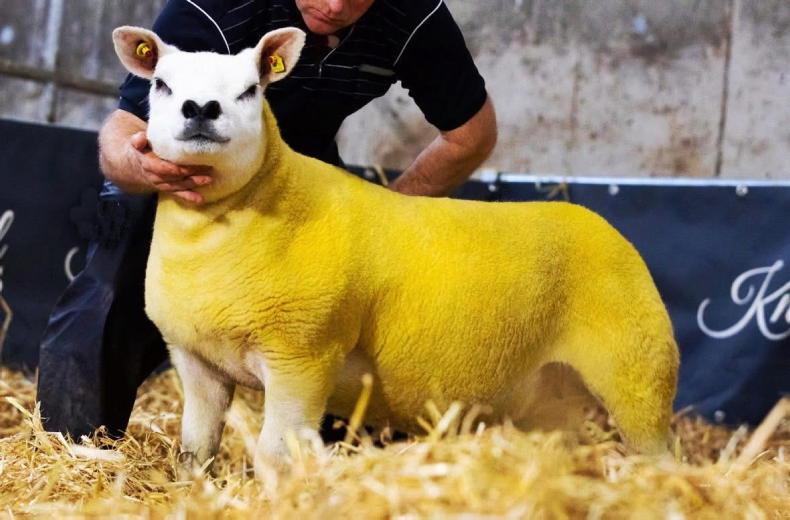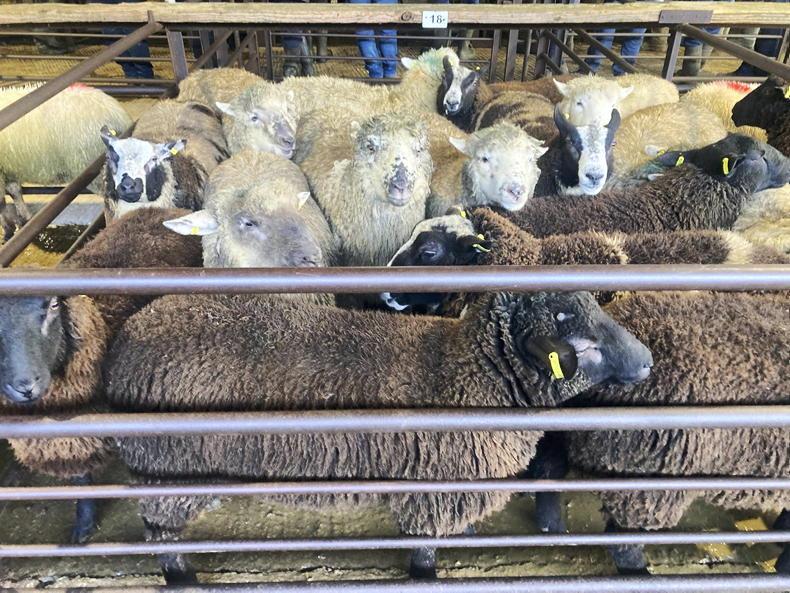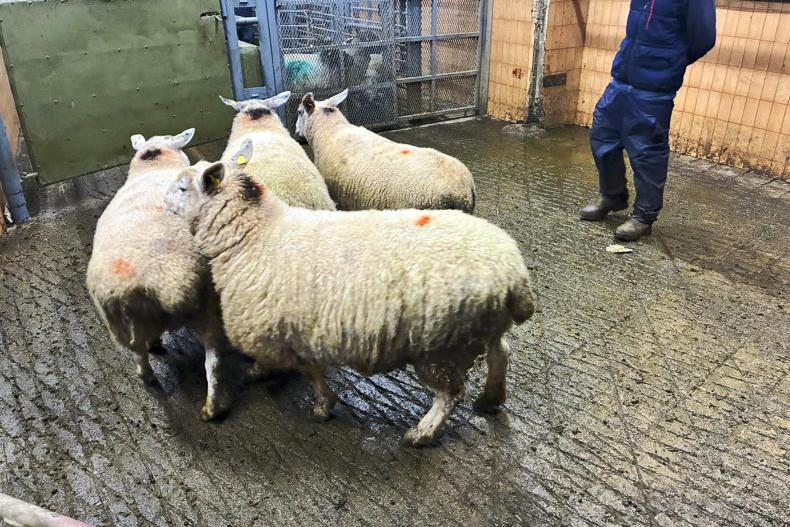Sales of store lambs are off and running, and the number of animals coming on to the market will be increasing week on week.
So far, prices have been positive, with mart managers indicating strong demand from regular buyers specialising in short keep animals.
There had been some fears that the rise in fertiliser and concentrate costs would potentially soften the market, with buyers looking to possibly reduce throughput and ease the pressure on grazing.
However, this has not been the case so far. Processing demand remains relatively strong, helping to keep a floor under the sheep market on both sides of the Irish border. This is filtering through to the store ring in terms of buyer confidence.
At the outset of the week, fat lamb prices were in the region of 550p to 560p/kg which is 70p to 80p/kg above factory prices in late July of last year.
Store lambs were making £90 to £95 for short keep animals with lowland breeding and lighter lots making upwards from £70 to £90 depending on flesh cover, weight and quality.
Specialist systems
While some farmers dip in and out of the store lamb trade, there are plenty of farmers that specialise in the trade.
Seasoned buyers rarely lose money on store lambs. As they tend to handle bigger numbers, they generally have greater negotiating power with processors when selling.
When done right, there is usually a margin to be had with store lambs, with a quick turn around on cash invested in stock.
But equally, under the wrong management, there are pitfalls that can see farmers losing a lot of money.
Know what to buy
For farmers venturing in to the store lamb trade for the first time, give careful thought to what type of animal will be purchased.
Also, give thought to how much grass is available and if a lack of grazing or housing means there is a date when animals need to be finished by.
Be aware that the majority of marts sell store lambs without weighing animals entering the ring. Therefore, it is important to arrive at the mart early, handle animals in the lairage before the sale starts and make a note of lot numbers.
The other thing is that many lots offered for sale will be a mix of male and female lambs. Ram lambs can be castrated or entire, which makes managing animals as a single group difficult.
Where possible, avoid buying pens with uneven sized animals and multiple breeds of sheep within each lot. Again, this makes lambs harder to manage.
Ram lambs that are not castrated will have higher growth rates than castrated males, but can be harder to finish off a grass-only diet in autumn as sward quality declines.
Lighter lambs will be cheaper to purchase, but will be on farm longer. Will you have enough grass to finish animals, or will housing for a short period be necessary?
Potential weight gain
Weight gain will also vary in lambs depending on breed type and grass quality. Lambs exhibiting lowland breeding, for example, Texel and Suffolk cross animals, should be capable of gaining 1.5kg to 2kg/week on good grass in August.
Weight gain is more likely to be 1.2kg to 1.5kg/week on good autumn grazing, slipping back to 1kg in November.
Lambs with a greater influence of hill breeding will more typically gain 1kg/week in early autumn, slipping back to 0.7kg to 0.8kg/week through late autumn to early winter.
Concentrates may be required as grass supply and quality tails off through the autumn period, although this should be confined to a short finishing period.
Introducing concentrates will increase finishing cost. But as performance improves, animals will reach slaughter weight earlier.
Carcase weight, fat cover and kill-out will also be improved, raising the monetary value of a lamb carcase.
For store lambs, feed conversion ratio is probably in the region of 8kg to 10kg of concentrate per 1kg of carcase gain.
So if concentrate costs £380/t and a hypothetical factory price is 550p/kg, a short meal feeding period will pay for itself.
Completing a finishing budget for store lambs
When buying store lambs, completing a simple budget is always time well spent to determine if there is a margin to be made or not.
But as is the case with any budget, a farmer must use realistic prices and weight gains. Using inflated sale prices, or unrealistic weight gains that have never been achieved in the past will make the exercise pointless.
As an example of completing a store lamb budget, a farmer buys 120 store lambs on 1 August.
Lambs are crossbred animals of good quality from a known upland flock of crossbred ewes mated to terminal sires.
Lambs are April born and approximately weigh 38kg liveweight when purchased. All animals are castrated males. Lambs cost £92/head when purchased.
The big question on the farmer’s mind is what price will be required to break-even when the lambs are sold for slaughter?
Target sale date
On arrival to the farm, the lambs are put on 20 acres of good quality grazing, giving a stocking rate of six lambs per acre.
Assuming lambs are likely to average 150g/day while on farm, the animals will gain just over 1kg/week.
Allowing for a kill-out percentage of 43% on autumn grass, target drafting weight is 50kg to yield a 21.5kg carcase.
Based on the outlined weight gain, lambs will be on farm for 12 weeks and reach their target slaughter weight by early November.
Inputs
To maintain grazing through the autumn, fertiliser is spread in August at a rate of 27 units/acre of CAN purchased at £650/t. Fertiliser costs come to £32.50/acre or £5.40/head.
Factoring in diesel, potential land rent and some miscellaneous costs at £5/head, this brings grazing costs to £10.40/head.
Concentrates are fed at a rate of 0.5kg/day for the final 21 days to stretch grass supply, improve fat cover and kill-out. Assuming the ration costs £380/t, meal costs come to £4/head.
Lambs also get a single dose for worm control costing £1/head and the farmer is aiming to turn a £10/head profit margin.
Break-even
Direct input costs to graze and finish the lambs come to £15.40/head. Adding in the £10/margin and purchase price of £92, the break-even cost comes to just over £117/head.
On a 21.5kg carcase, the break-even price equates to 546p/kg. For every £5 increase or decrease in the purchase price of lambs, the break-even price will change by 23p/kg.
Read more
Beef quotes steady with cows in demand
Sheep mart prices: hogget sales starting brightly
Sales of store lambs are off and running, and the number of animals coming on to the market will be increasing week on week.
So far, prices have been positive, with mart managers indicating strong demand from regular buyers specialising in short keep animals.
There had been some fears that the rise in fertiliser and concentrate costs would potentially soften the market, with buyers looking to possibly reduce throughput and ease the pressure on grazing.
However, this has not been the case so far. Processing demand remains relatively strong, helping to keep a floor under the sheep market on both sides of the Irish border. This is filtering through to the store ring in terms of buyer confidence.
At the outset of the week, fat lamb prices were in the region of 550p to 560p/kg which is 70p to 80p/kg above factory prices in late July of last year.
Store lambs were making £90 to £95 for short keep animals with lowland breeding and lighter lots making upwards from £70 to £90 depending on flesh cover, weight and quality.
Specialist systems
While some farmers dip in and out of the store lamb trade, there are plenty of farmers that specialise in the trade.
Seasoned buyers rarely lose money on store lambs. As they tend to handle bigger numbers, they generally have greater negotiating power with processors when selling.
When done right, there is usually a margin to be had with store lambs, with a quick turn around on cash invested in stock.
But equally, under the wrong management, there are pitfalls that can see farmers losing a lot of money.
Know what to buy
For farmers venturing in to the store lamb trade for the first time, give careful thought to what type of animal will be purchased.
Also, give thought to how much grass is available and if a lack of grazing or housing means there is a date when animals need to be finished by.
Be aware that the majority of marts sell store lambs without weighing animals entering the ring. Therefore, it is important to arrive at the mart early, handle animals in the lairage before the sale starts and make a note of lot numbers.
The other thing is that many lots offered for sale will be a mix of male and female lambs. Ram lambs can be castrated or entire, which makes managing animals as a single group difficult.
Where possible, avoid buying pens with uneven sized animals and multiple breeds of sheep within each lot. Again, this makes lambs harder to manage.
Ram lambs that are not castrated will have higher growth rates than castrated males, but can be harder to finish off a grass-only diet in autumn as sward quality declines.
Lighter lambs will be cheaper to purchase, but will be on farm longer. Will you have enough grass to finish animals, or will housing for a short period be necessary?
Potential weight gain
Weight gain will also vary in lambs depending on breed type and grass quality. Lambs exhibiting lowland breeding, for example, Texel and Suffolk cross animals, should be capable of gaining 1.5kg to 2kg/week on good grass in August.
Weight gain is more likely to be 1.2kg to 1.5kg/week on good autumn grazing, slipping back to 1kg in November.
Lambs with a greater influence of hill breeding will more typically gain 1kg/week in early autumn, slipping back to 0.7kg to 0.8kg/week through late autumn to early winter.
Concentrates may be required as grass supply and quality tails off through the autumn period, although this should be confined to a short finishing period.
Introducing concentrates will increase finishing cost. But as performance improves, animals will reach slaughter weight earlier.
Carcase weight, fat cover and kill-out will also be improved, raising the monetary value of a lamb carcase.
For store lambs, feed conversion ratio is probably in the region of 8kg to 10kg of concentrate per 1kg of carcase gain.
So if concentrate costs £380/t and a hypothetical factory price is 550p/kg, a short meal feeding period will pay for itself.
Completing a finishing budget for store lambs
When buying store lambs, completing a simple budget is always time well spent to determine if there is a margin to be made or not.
But as is the case with any budget, a farmer must use realistic prices and weight gains. Using inflated sale prices, or unrealistic weight gains that have never been achieved in the past will make the exercise pointless.
As an example of completing a store lamb budget, a farmer buys 120 store lambs on 1 August.
Lambs are crossbred animals of good quality from a known upland flock of crossbred ewes mated to terminal sires.
Lambs are April born and approximately weigh 38kg liveweight when purchased. All animals are castrated males. Lambs cost £92/head when purchased.
The big question on the farmer’s mind is what price will be required to break-even when the lambs are sold for slaughter?
Target sale date
On arrival to the farm, the lambs are put on 20 acres of good quality grazing, giving a stocking rate of six lambs per acre.
Assuming lambs are likely to average 150g/day while on farm, the animals will gain just over 1kg/week.
Allowing for a kill-out percentage of 43% on autumn grass, target drafting weight is 50kg to yield a 21.5kg carcase.
Based on the outlined weight gain, lambs will be on farm for 12 weeks and reach their target slaughter weight by early November.
Inputs
To maintain grazing through the autumn, fertiliser is spread in August at a rate of 27 units/acre of CAN purchased at £650/t. Fertiliser costs come to £32.50/acre or £5.40/head.
Factoring in diesel, potential land rent and some miscellaneous costs at £5/head, this brings grazing costs to £10.40/head.
Concentrates are fed at a rate of 0.5kg/day for the final 21 days to stretch grass supply, improve fat cover and kill-out. Assuming the ration costs £380/t, meal costs come to £4/head.
Lambs also get a single dose for worm control costing £1/head and the farmer is aiming to turn a £10/head profit margin.
Break-even
Direct input costs to graze and finish the lambs come to £15.40/head. Adding in the £10/margin and purchase price of £92, the break-even cost comes to just over £117/head.
On a 21.5kg carcase, the break-even price equates to 546p/kg. For every £5 increase or decrease in the purchase price of lambs, the break-even price will change by 23p/kg.
Read more
Beef quotes steady with cows in demand
Sheep mart prices: hogget sales starting brightly









SHARING OPTIONS